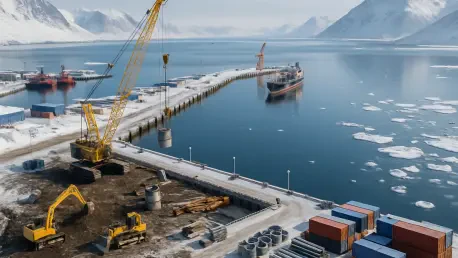Imagine a remote Alaskan town, cut off from major road networks, where the lifeline of goods, services, and safety hinges on a century-old port struggling to accommodate modern vessels, a reality faced by Nome, a critical hub on Alaska’s western coast, now at the center of a transformative infrastructure project. On August 15 of this year, the U.S. Army Corps of Engineers awarded Kiewit Infrastructure West Co. a $399.4 million contract for Phase 1A of the Port of Nome expansion. This roundup dives into diverse opinions, insights, and analyses from industry experts, policymakers, and regional stakeholders to unpack the significance of this endeavor. The goal is to explore how this project could reshape connectivity, economy, and security in the Arctic while addressing the challenges that lie ahead.
Diverse Voices on a Historic Arctic Project
Industry Experts Weigh In on Engineering Feats
Professionals in the construction and engineering sectors have expressed optimism about Kiewit’s role in tackling the complex challenges of the Port of Nome overhaul. Many highlight the technical precision required for Phase 1A, which includes building a 1,200-foot causeway extension with 600 feet of dock face in harsh Arctic conditions. The consensus is that such infrastructure demands innovative approaches to withstand extreme weather and logistical hurdles.
Some industry observers, however, caution that timelines could be tested by unpredictable environmental factors. Delays in material transport or unexpected permafrost issues are cited as potential setbacks. These concerns underscore a broader call for adaptive planning and robust risk management in Arctic projects, setting this initiative apart as a benchmark for future endeavors in remote regions.
A contrasting viewpoint emphasizes the long-term payoff of such investments. Engineers familiar with port expansions argue that deepening the harbor to accommodate larger vessels will revolutionize maritime access, potentially reducing the need for constant dredging. This perspective frames the project as a critical step toward sustainable infrastructure in isolated areas.
Regional Stakeholders Highlight Economic Potential
Community leaders and business owners in Nome and surrounding areas view the port expansion as a vital boost to regional economies. The ability to receive larger ships is expected to lower transportation costs and improve access to essential goods, addressing long-standing isolation due to the lack of road connectivity. Many see this as a transformative opportunity for growth in trade and commerce.
On the flip side, some local voices raise concerns about environmental impacts and the risk of cost overruns affecting community trust. There’s apprehension that rapid development might disrupt marine ecosystems or strain local resources during construction. These stakeholders advocate for transparent dialogue and strict oversight to balance progress with sustainability.
A third angle from regional economic planners focuses on job creation and skill development tied to the project. The influx of construction work is anticipated to provide employment opportunities, potentially fostering long-term economic resilience. This viewpoint pushes for integrating local workforce training into the project’s framework to maximize benefits for the community.
Policy Analysts Discuss Strategic Importance
From a national perspective, policy analysts underscore the port’s role in bolstering U.S. presence in the Arctic, especially amid growing geopolitical interest in the region. The upgraded facility is seen as a strategic asset for military operations and public safety missions, aligning with broader infrastructure goals set by federal funding mechanisms like the 2021 Infrastructure Investment and Jobs Act.
Diverging opinions emerge on whether the focus on large-scale modernization might overshadow smaller, more immediate upgrades. Some analysts question if resources could be better allocated to incremental improvements rather than a sweeping overhaul, citing the high financial stakes of nearly $400 million for just the initial phase. This debate highlights a tension between ambition and practicality in remote infrastructure planning.
Another policy lens emphasizes alignment with Arctic research and emergency response needs. Experts in this sphere argue that an enhanced Port of Nome could serve as a hub for scientific expeditions and disaster preparedness, reinforcing national interests. This perspective adds a layer of multi-purpose utility to the discussion, framing the project as a cornerstone of broader Arctic strategy.
Environmental Advocates Call for Caution
Environmental groups and advocates bring a critical dimension to the conversation, stressing the need to protect fragile Arctic ecosystems during the port’s expansion. Concerns center on potential disruptions to marine life and coastal habitats caused by dredging and construction activities. Many urge stringent mitigation measures to minimize ecological harm.
A differing stance within environmental circles acknowledges the necessity of improved maritime access but pushes for sustainable design. Some suggest incorporating green technologies or renewable energy solutions into the port’s infrastructure to offset carbon footprints. This forward-thinking approach seeks to harmonize development with conservation goals.
Yet another viewpoint warns of long-term climate risks amplified by Arctic projects. Rising sea levels and melting ice could challenge the port’s durability, prompting calls for climate-resilient engineering. This concern reflects a broader anxiety about balancing immediate infrastructure needs with the unpredictable impacts of global warming in such a vulnerable region.
Reflecting on a Milestone for Arctic Infrastructure
Looking back, the roundup of perspectives on Kiewit’s $399.4 million contract for the Port of Nome expansion reveals a spectrum of hopes, concerns, and strategic insights. Industry experts marvel at the engineering challenges while cautioning against environmental hurdles. Regional stakeholders celebrate economic prospects but seek safeguards for sustainability. Policy analysts recognize national security benefits, though some question the scale of investment, and environmental advocates urge a careful balance with nature. These discussions paint a nuanced picture of a project that carries immense potential alongside significant risks. Moving forward, stakeholders should prioritize collaborative planning, integrating community input, environmental protections, and adaptive strategies to ensure the port’s success. Exploring similar Arctic initiatives or engaging with policy updates on infrastructure funding could provide deeper understanding and guide future actions in this critical frontier.









